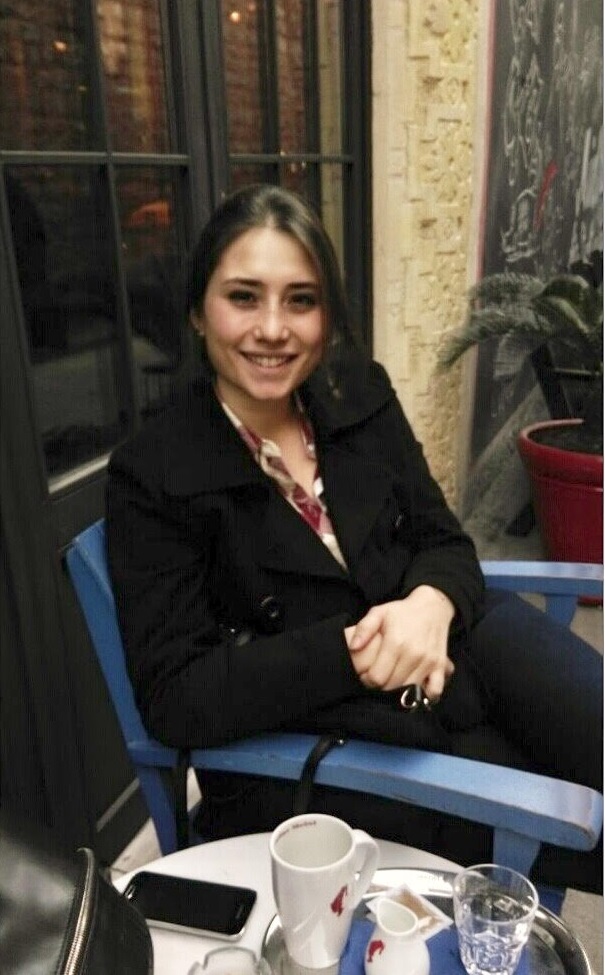Aysima Hacisuleyman, PhD Candidate
 I earned my bachelor’s degree from Koç University, Chemical and Biological Engineering. Shortly after my graduation I joined Erman Research group as a Ph.D student in the department of Chemical and Biological Engineering at Koç University. My research is based on finding allosteric communication networks, detecting information transmitter-receiver relationships between residue pairs in proteins and nanobody modelling. Allostery is an intrinsic property of proteins which is entropic in nature. Allosteric communication depends on information transfer between distant parts of the protein. Mutation, ligand binding, protein-protein interaction can alter this communication network by changing the conformational transitions and preferences in the protein that result from its dynamic fluctuations. I use molecular Dynamics (MD) methods and the dynamic version of Gaussian Network Model (dGNM) to detect these changes. I combine statistical mechanics and information theory in my analyses. Nanobody is a single domain antibody which can selectively bind to an antigen. Due to their small size and unique structure, nanobodies are ideal building blocks for the generation of novel biological drugs. I use Molecular Dynamics (MD) and Steered Molecular Dynamics (SMD) to find the optimum nanobody sequence for specific antigens.
I earned my bachelor’s degree from Koç University, Chemical and Biological Engineering. Shortly after my graduation I joined Erman Research group as a Ph.D student in the department of Chemical and Biological Engineering at Koç University. My research is based on finding allosteric communication networks, detecting information transmitter-receiver relationships between residue pairs in proteins and nanobody modelling. Allostery is an intrinsic property of proteins which is entropic in nature. Allosteric communication depends on information transfer between distant parts of the protein. Mutation, ligand binding, protein-protein interaction can alter this communication network by changing the conformational transitions and preferences in the protein that result from its dynamic fluctuations. I use molecular Dynamics (MD) methods and the dynamic version of Gaussian Network Model (dGNM) to detect these changes. I combine statistical mechanics and information theory in my analyses. Nanobody is a single domain antibody which can selectively bind to an antigen. Due to their small size and unique structure, nanobodies are ideal building blocks for the generation of novel biological drugs. I use Molecular Dynamics (MD) and Steered Molecular Dynamics (SMD) to find the optimum nanobody sequence for specific antigens.
ALUMNI
Sezen Vatansever, MD, PhD

I earned my Bachelor’s degree from Ankara University School of Medicine. After graduation, I worked as a general practitioner for two years in various positions (i.e. emergency care, family medicine, public health care, occupational health and safety, forensic medicine) to complete my mandatory service duty. Now, I am a PhD candidate in the department of Biomedical Sciences and Engineering at Koc University, and a research and teaching assistant in the same department.
Considering drug development stages, drug repositioning is an advantageous strategy to
discover new and innovative indications of existing drug compounds. I am interested in
finding out general principles of drug repositioning by means of specific problems. The first
study is antiviral discovery against Crimean Congo Hemorrhagic Fever Virus. The second is
drug design for treatment of KRAS-mutated cancers. I apply molecular docking and
molecular dynamics (MD) simulation methods to repositioning approach. I am focused on
protein-ligand binding, MD simulation and analysis of target proteins, parameterization of
non-standard drug-like compounds, steered MD of protein-ligand systems, viral protein-RNA
interaction, KRAS mutation-structure-function relationship.
Nergis Gunindi, MS
I have completed my Bachelor of Science Degree in Bioengineering which is a dual degree program both at Istanbul Technical University and Montana State University,USA. I was the highest ranking student of my department in Istanbul Technical University. Currently I am Master of Science student in Chemical and Biological Engineering department at Koc University and a member of Erman Research Group.
I am working on procaspase-1 enzyme and its activated form caspase-1 with Molecular Dynamics Simulations. Caspase-1 has two subunits which are p20 and p10. After it is activated these dimers form a tetramer. The aim of the Project is to observe the change in the active site, after the procaspase-1 became active. During this activation process if there is any allostery which affects the active site, the conformational changes in the protein will be observed. The aim is to answer the questions “Is active site cleft closed in the procaspase-1?” “What happens when it becomes a tetramer?” “How does the allosteric effect proceed in the active site?” All of the observations will be determined by comparing the inactivated and activated form of caspase-1 protein with respect to their differences on MD.
Ebru Cetin, MS
 I completed my Bachleor’s degree in Koç University, Chemical and Biological Engineering Department. After one year of experience in private sector, I have started in Computational Sciences and Engineering Master Program.
I completed my Bachleor’s degree in Koç University, Chemical and Biological Engineering Department. After one year of experience in private sector, I have started in Computational Sciences and Engineering Master Program.
During my master studies, I worked on β2-Adrenergic protein. β2-Adrenergic is an important protein for smooth muscle relaxation lacking of which causes asthma. I studied structural protein dynamics using molecular docking, molecular dynamics simulations (MD) and steered-MD method for lipid-protein and/or ligand-protein systems of β2-Adrenergic.
Andleeb Zahra
PhD scholar-TUBITAK Research fellow
I completed my MS Bioninformatics from Government College University Faisalabad, Pakistan. PhD scholar at Comsats Institute of Information Technology Islamabad, Pakistan.
Oral Cancer has become global health issue. Its malignancies include cheeks, lips, oral cavity and pharynx, and it can affect more than 481,000 new patients worldwide each year. The assessment of multiple miRNA expression levels, also referred to as miRNA signatures, can accurately predict prognosis in various types of cancers challenges in oral cancer diagnosis and treatment. miRNAs are by-products of dead cells that remain in extracellular space for at least one month due to the high stability of the Ago2–miRNA complex. miRNA–Ago complexes can be specifically released from cells and confer cell to-cell communication. This phenomena needs to be investigated. The high stability of the complex suggests the possibility of using extracellular miRNA as a biomarker for cancer, tissue/organ damages, and viral infections. Therefore, miRNA profiling can be used in cancer detection studies at early stages.
become global health issue. Its malignancies include cheeks, lips, oral cavity and pharynx, and it can affect more than 481,000 new patients worldwide each year. The assessment of multiple miRNA expression levels, also referred to as miRNA signatures, can accurately predict prognosis in various types of cancers challenges in oral cancer diagnosis and treatment. miRNAs are by-products of dead cells that remain in extracellular space for at least one month due to the high stability of the Ago2–miRNA complex. miRNA–Ago complexes can be specifically released from cells and confer cell to-cell communication. This phenomena needs to be investigated. The high stability of the complex suggests the possibility of using extracellular miRNA as a biomarker for cancer, tissue/organ damages, and viral infections. Therefore, miRNA profiling can be used in cancer detection studies at early stages.
Our aim is to provide a significant way for early detection of oral cancer. For this purpose bioinformatics approaches will be used to identify the best miRNA-mRNA-protein complex using molecular docking techniques. The molecular dynamics simulations will be used to predict the structure, dynamics as well as thermodynamics behavior of these complexes. Most stable miRNA-mRNA-Protein complex with shortest reaction time will be used for experimental validation.
Cenk Denktas, PhD
Research Scholar-Yildiz Technical University
The i nvestigation structural and dynamical of the protein-peptide interactions and peptides in Behçet’s Disease with moleculer dynamic (MD) simulations, statistical mechanic theory and steered molecular dynamics (SMD)
nvestigation structural and dynamical of the protein-peptide interactions and peptides in Behçet’s Disease with moleculer dynamic (MD) simulations, statistical mechanic theory and steered molecular dynamics (SMD)
The primary goal of our body’s defense system is to protect our body from foreign objects such as bacteria, virus and cancer. For that reason, there is a system that distinguishes what belongs and what doesn’t belong to us. If our body can’t identify the foreign object, it won’t fight against it as it will recognize it as a part of our body. HLA is a human leukocyte antigen gene system which helps to identify what doesn’t belong to our body and they code the proteins which will fulfill this task and are called as HLA antijens. They have key role in forming immune response as moleculs in the task of presenting both its own and foreign peptides to T lenfosits. HLA antijens are categorized into 3 groups according to their structural and functional characteristics (Class 1, Class 2, Class 3). Class 1 and Class 2 forms resistant complexes on HLA proteins by binding different peptides. However, some mutations which are formed on this proteins affect whether peptides are linked well and they lead to the formation of several diseases such as ankilozan spondalit, sistemik lupus, type 1 diabetes, Behcet disease and otoimun chronic hepatit-B.
In this study, the statistical thermodynamics and dynamic characteristics of HLA- B *51:01/peptide interactions (unbound and bound states) and peptides whose relation is proved experimentally with HLA- B *51:01, which is HLA Class 1 protein and leads to Behcet disease that is widely seen in our country will be investigated [1-2]. Meanwhile, the HLA- B *52:01/peptide interactions (unbound and bound states) and HLA-B*52:01 protein peptides which have two amino acid difference from HLA-B*51:01 and don’t lead to any disease will also be investigated. In the framework of the research, molecular dynamic (MD) will be used to identify peptides behaviours and this methods will use CHARMM27 force field and NAMD 2.10b1 MD programs. The structural energy of peptides and protein-peptide interactions (unbound and bound states), average energy, entropy and statistical thermodynamic functions such as temperature capacity will be calculated using statistical analysis approach and using results obtained from MD simulations, This approach will be in the form of application of Rotational Isomeric State Model (RIS) which is developed for polymer theory and in which a series of matrix multiplication is made to peptides [3-6]. Then, effect of force on protein-peptide interactions (bound states) structural and dynamical properties is investigated by steered molecular dynamics (SMD) simulations. SMD simulations have been key to provide molecular details about the associated mechanisms for protein-peptide interactions (unbound and bound states).
References:
[1] Gül, A. 2001. “Behcet’s disease: An update on the pathogenesis”, Clinical and Experimental Rheumatology, 19 (Suppl. 24), 6-12. [2] Remmers, E.F., Cosan, F., Kirino, Y., Ombrello, M.J., Abaci, N., Satorius, C., Le, J.M., Yang, B., Korman, B.D., Cakiris, A., Aglar, O., Emrence, Z., Azakli, H., Ustek, D.,Tutkun, I.T., Demir, G.A., Chen, W., Amos, C.I., Dizon, M.B., Kose, A.A., Azizlerli, G., Erer, B., Brand, O.J., Kaklamani, V.G., Kaklamanis, P., Chetrit, E.B., Stanford, M., Fortune, F., Ghabra, M., Ollier, W.E.R., Cho, Y.H., Bang, D., Shea, J., Wallace, G.R., Gadina, M., Kastner, D.L. & Gül, A. 2010. “Genome-wide association study identifies variants in the MHC class I, IL10, and IL23R-IL12RB2 regions associated with Behçet’s disease”, Nature Genetics, doi:10.1038/ng.625. [3] Engin, O., Sayar, M. and Erman, B. 2009. “The introduction of hydrogen bond and hydrophobicity effects into the rotational isomeric states model for conformational analysis of unfolded peptides”, Phys. Biol., 6, 016001. [4] Unal, E.B., Gursoy, A. and Erman, B. 2009. “Conformational energies and entropies of peptides, and the peptide–protein binding problem”, Phys. Biol., 6, 036014. [5] Keskin, O., Yuret, D., Gursoy, A., Turkay, M., and Erman, B. 2004. “Relationships Between Amino Acid Sequence and Backbone Torsion Angle Preferences”, PROTEINS: Structure, Function, and Bioinformatics 55:992–998. [6] GURSOY, A., KESKIN, O., TURKAY, M., ERMAN, B. 2006. “Relationships Between Unfolded Configurations of Proteins and Dynamics of Folding to the Native State”, Journal of Polymer Science: Part B: Polymer Physics, 44, 3667–3678.
